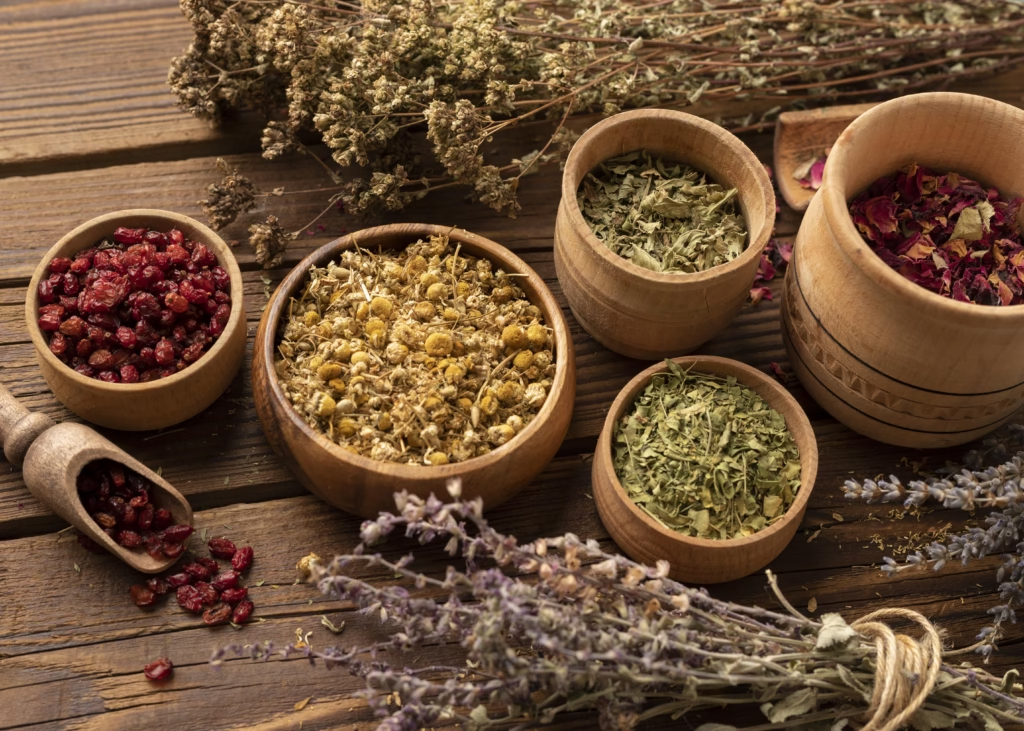Why Seasonal Ayurvedic Herbs Matter for Healthcare MSMEs
Table of Contents
Introduction
In Ayurveda, nature’s rhythm plays a key role in health.
Each season affects the body differently. To stay balanced, we must adjust our diet and lifestyle.
One important way is by using Seasonal Ayurvedic Herbs.
These herbs help manage seasonal imbalances, build immunity, and support overall wellness.
For Healthcare MSMEs, seasonal herbs offer a huge business opportunity.
Clinics, wellness centers, and Ayurvedic product sellers can stock and promote season-specific herbs.
This not only helps customers but also boosts trust and brand value.
In this article, let’s explore the top herbs for summer, monsoon, and winter, and where to source them affordably.
Let’s begin with summer herbs first.
1. Which Ayurvedic herbs are in high demand during each Indian season, and why are they used?
Seasonal health issues change throughout the year. So do the herbs people look for.
If you are a supplier or seller, aligning your stock with seasonal demand is a smart move.
Here’s a simple breakdown of the most popular Seasonal Ayurvedic Herbs and why they are needed in each season:
Summer Season (March to June)
Summer brings heat, dehydration, and excess Pitta in the body.
People suffer from acidity, skin rashes, and low energy.
The following herbs are used for their cooling and soothing properties:
- Coriander (Dhanyaka): Known to cool the body and improve digestion. Popular in Ayurvedic drinks and powders.
- Aloe Vera (Kumari): Helps with skin issues, acidity, and internal heat. Also supports gut health.
- Mint (Pudina): Reduces body heat and helps with gas and nausea.
- Fennel (Shatapushpa): Soothes digestion and relieves bloating.
- Coconut: Hydrating and rich in electrolytes. Used in drinks and oil form.
- Shatavari: Rejuvenating and cooling. Especially used for women’s health.
- Sandalwood (Chandana): Cooling for the skin. Common in face packs and oils.
- Mulethi (Licorice): Balances heat, improves digestion, and soothes the throat.
- Lemongrass: A Refreshing herb for tea and skincare.
- Amalaki (Amla): Rich in Vitamin C and antioxidants. Builds immunity and supports skin health.
Rainy Season (July to September)
During the monsoon, the body’s immunity drops. Cold, cough, and fever are common. Moisture also increases the risk of infections.
So the focus is on herbs that boost immunity and improve respiratory health:
- Tulsi (Holy Basil): A Powerful herb for fighting infections and boosting respiratory strength.
- Giloy (Guduchi): Strengthens immunity and helps manage fevers and viral infections.
- Ashwagandha: Reduces stress, supports the immune system, and promotes overall vitality.
These Seasonal Ayurvedic Herbs are especially helpful for Healthcare MSMEs in wellness clinics, pharmacies, and Ayurvedic stores during the monsoon.
Winter Season (October to February)
In winter, the body’s digestion is stronger, but cold weather brings joint pain, stiffness, and weak immunity.
Herbs that generate warmth and boost strength are in high demand:
- Turmeric (Haldi): Anti-inflammatory, supports immunity, and helps with joint health.
- Tulsi: Again, useful in winter for colds and breathing issues.
- Ashwagandha: Keeps the body warm, builds stamina, and helps in stress management.
Summary
Stocking season-specific herbs can help you meet the changing needs of your customers.
Healthcare MSMEs who adjust their inventory based on the time of year are more likely to succeed.
Use this seasonal guide as your sourcing and marketing calendar.
It not only ensures better sales but also positions your brand as thoughtful and wellness-focused.
2. Where can MSME Ayurvedic manufacturers source fresh and certified seasonal herbs in India?
If you’re an MSME making Ayurvedic products, sourcing the right Seasonal Ayurvedic Herbs is the first step.
The quality of your ingredients decides the quality of your final product.
So, it’s important to know where to buy herbs that are both fresh and certified.
Here’s a simple guide to help Healthcare MSMEs find reliable suppliers across India:
1. Trusted Wholesale Markets
Many big herbal wholesale mandis in India specialize in bulk supply of seasonal herbs. These markets offer fresh and dried herbs, often in raw form:
- Khari Baoli, Delhi: One of Asia’s largest spice and herbal markets. You can find herbs like tulsi, ashwagandha, mulethi, and more here.
- Unjha Market, Gujarat: Famous for fennel, coriander, and cumin. It’s a great source for summer cooling herbs.
- Nashik & Pune Markets, Maharashtra: Good for amla, turmeric, and other seasonal fruits and herbs grown in nearby farms.
- Kottakkal, Kerala: This town is a hub for traditional Ayurvedic herbs. Many suppliers here offer authentic South Indian herbs and oils.
Tip: While buying from wholesale markets, check if the seller provides basic certificates or lab tests for herb quality.
2. Government-Approved Herbal Clusters
To support Healthcare MSMEs, the Indian government has promoted herbal cultivation and trade through clusters and missions:
- AYUSH Clusters: Many states now have AYUSH (Ayurveda, Yoga, Unani, Siddha, Homeopathy) clusters under the Ministry of AYUSH.
These clusters ensure quality cultivation and post-harvest processing.
- National Medicinal Plants Board (NMPB): This board helps MSMEs connect with certified cultivators and producers of herbs.
You can check their directory or connect through state-level AYUSH departments.
- State Medicinal Plant Boards: Every state has its own board that lists registered growers and processors of Ayurvedic herbs.
These platforms are safer than open markets because sellers are usually traceable and certified.
3. Forest Produce and Tribal Cooperatives
Some of the best wild Ayurvedic herbs come directly from India’s forests.
Tribal communities harvest these naturally, and many are now organized under cooperatives:
- TRIFED (Tribal Co-operative Marketing Development Federation): This government-backed group helps tribal producers sell herbs like giloy, amla, and turmeric with proper documentation.
- State Forest Development Corporations: These supply forest-based herbs through eco-friendly harvesting.
Many have online tenders or bulk purchase systems for MSMEs.
If your business wants to focus on organic or wild-crafted ingredients, this is a great option.
4. Reputed Online Platforms and B2B Marketplaces
For faster sourcing, many Healthcare MSMEs also use verified online platforms that connect buyers and certified herb growers:
- IndiaMART and TradeIndia: Look for sellers with FSSAI, ISO, or AYUSH certifications.
- Organic India, Just Herbs, or Phalada Pure & Sure: Though more retail-focused, these brands also have B2B supply options for premium herbs.
- Krishi Jagran and eNAM: These platforms sometimes list seasonal herb produce from farmers directly.
Final Note
Always request lab test reports, FSSAI/AYUSH license, and harvest date when you source.
The more transparent the seller is, the more confident your customers will be in your brand.
By sourcing your Seasonal Ayurvedic Herbs from reliable and certified suppliers, you not only protect your product quality but also stay compliant and competitive in the market.
3. How can Ayurvedic businesses forecast seasonal herb demand and avoid stockouts or overbuying?
For any Healthcare MSME dealing in Seasonal Ayurvedic Herbs, proper demand forecasting is key.
If you buy too much, the herbs may spoil.
If you buy too little, you miss out on sales.
So, finding the right balance helps save money, manage stock better, and keep your business running smoothly all year.
Here’s how you can plan smartly and avoid both stockouts and overbuying:

1. Study Past Sales Trends
Start by looking at your own business data. Ask yourself:
- Which herbs sold the most last summer, monsoon, or winter?
- When did the demand start to rise?
- When did it fall?
You can track this using simple Excel sheets or inventory tools. If you are a new business, speak to local wholesalers, retailers, or search market reports for basic trends.
Example: If tulsi and giloy sold fast last monsoon, you can plan to stock them 1–2 months before the season begins.
2. Use Seasonal Health Trends
Different seasons bring different health problems.
So, align your stock with what people need:
- Summer: Herbs that cool the body, like coriander, mint, and amla
- Monsoon: Immunity boosters like tulsi, giloy, and ashwagandha
- Winter: Warming and anti-inflammatory herbs like turmeric, shatavari
Keeping track of seasonal health tips from Ayurvedic doctors or wellness platforms can help you guess which herbs will be in demand.
3. Plan Based on Shelf Life
Each herb has a different shelf life.
Some, like dried turmeric or ashwagandha, last for months. Others, like fresh mint or aloe vera, spoil quickly.
Plan your stock based on:
- How long will the herb stay fresh
- How fast can you sell it?
- Storage conditions at your location
Use “First-In, First-Out” (FIFO) methods to sell older stock before new stock. This avoids wastage and saves money.
4. Talk to Distributors and Clinics
Ayurvedic shops, wellness clinics, and pharmacies can help you get a clearer picture of expected demand.
Try to build a pre-order system with your regular customers.
Example: Offer advance booking of monsoon immunity kits.
Based on pre-orders, you’ll know how much tulsi or giloy to buy.
5. Start Small and Scale Gradually
If you’re unsure about demand, begin with smaller batches of high-demand herbs. Once the season picks up, you can quickly reorder if needed.
Tie up with herb suppliers who offer quick turnaround or flexible MOQs (Minimum Order Quantities). This reduces cash stuck in slow-moving stock.
6. Use Simple Inventory Software
You don’t need expensive software. Even basic tools like Zoho Inventory, the Vyapar app, or Excel sheets can help you:
- Track stock movement
- Get low-stock alerts
- Forecast next month’s requirements
Some tools also give reports that show which herbs are moving faster, helping you make quicker decisions.
Final Tip
Always leave room for emergency restocking.
Herbal demand can shoot up suddenly, especially during seasonal illness waves.
Build strong relationships with multiple herb suppliers so that you’re never stuck.
By predicting herb demand correctly and buying smartly, Ayurvedic businesses can maintain healthy cash flow, avoid storage problems, and serve customers better throughout the year.
Conclusion:
Seasonal Ayurvedic herbs are essential for small wellness and healthcare MSMEs that want to meet changing customer needs across summer, monsoon, and winter.
By understanding which herbs are in high demand in each season, sourcing from trusted clusters and government bodies, and forecasting demand using past trends and shelf-life planning, Ayurvedic businesses can avoid stockouts, reduce wastage, and improve cash flow.
Proper planning also strengthens customer trust and ensures your store is always ready with the right herbal solutions at the right time.
FAQs:
- What are the best Ayurvedic herbs for summer, monsoon, and winter?
Coriander, mint, and aloe vera are ideal for summer. Tulsi and giloy are best for monsoon. Turmeric and ashwagandha are suited for winter.
- Where can MSMEs buy certified seasonal Ayurvedic herbs in India?
MSMEs can source from local mandis, government herbal parks, tribal boards, and licensed Ayurvedic herb wholesalers.
- How can I predict which herbs to stock before each season?
Track past sales, follow seasonal health trends, and collect pre-orders from customers to plan your stock early.
- What tools can help forecast demand and manage Ayurvedic herb inventory?
Simple inventory tools like Vyapar, Zoho, or Excel sheets help manage stock levels, expiry tracking, and sales forecasting.
- Why is shelf-life planning important for seasonal herbs?
Many herbs spoil fast. Knowing shelf life ensures you don’t overstock or waste products, especially those sold fresh or semi-dried.
Also Read,
- The Ultimate Guide: Working Capital Loans for Small Business (MSMEs) in 2025
Understanding the Impact of Payment Terms on Working Capital for Clinics
How Poor Inventory Management Hurts Working Capital in Pharmacies.
Want a Better Business Credit Score? Small Pharmacies Can Now Use UPI & Cards to Build It
Want a Better Credit Score? Use Small Daily Payments to Build Your CBIL (For Clinics & Pharmacies)
Case Study:How a Small Clinic Improved Its Working Capital Management





